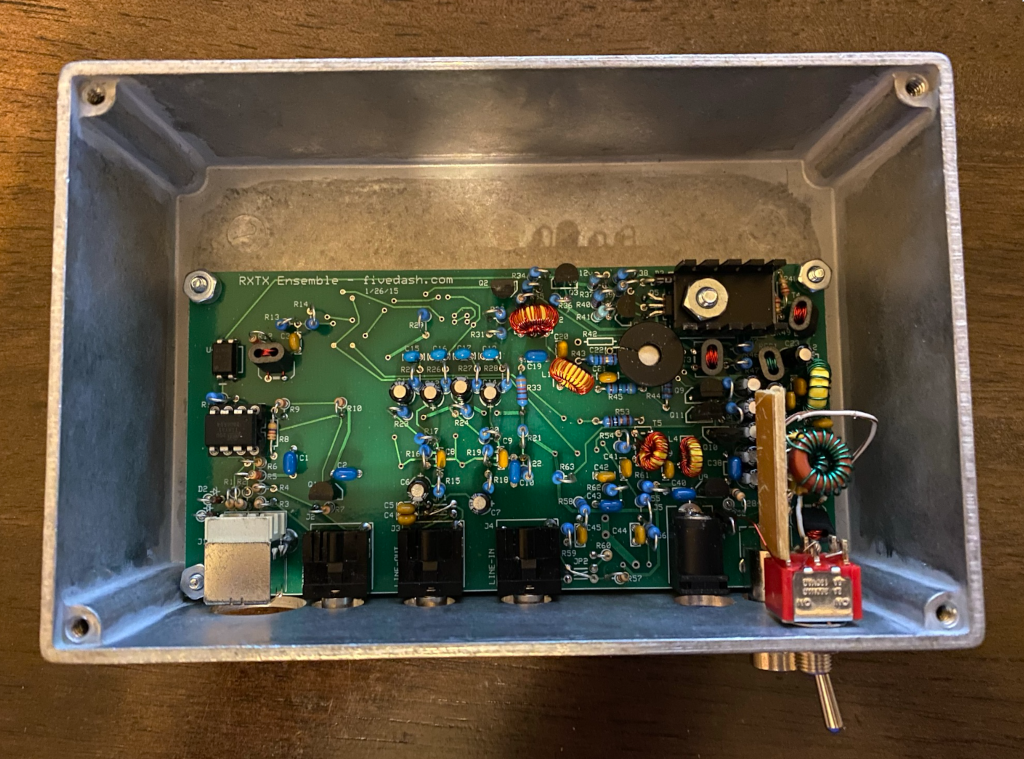Softrock RXTX QRPp transceiver
The Softrock RXTX [WB5RVZ] is an all-mode QRPp kit transceiver with I/Q receive and transmit, intended to be used with a computer.
The radio contains a Si570 oscillator, from which two clock signals (in phase and in quadrature) are derived. These are used for both I/Q demod in a direct-conversion receiver, and for I/Q modulation for transmit. The oscillator frequency and other control signals are controlled by a AVR microcontroller, which in turn has a USB interface.
The radio is powered from 12 volts, and puts out about one watt out. The PA consists of two BS170 MOSFETs in push-pull.
This was the first ham radio kit I put together. I bought the 40/30/20m version since I knew I wanted 40 and 20 meters. It took me a few months to go from the first stage (the power supply) to making QSOs. I started in late 2020 and finished in March 2021, right after the winter storm in Texas that year. I ran into many problems caused by mistakes on my part, and describe some of these here.
Getting the receiver working
The receiver was fairly simple to get running. I did not encounter problems while assembling this part, except for a solder bridge that always caused the radio to switch into "transmit," muting the receiver. The transmit circuits were not yet in place, so this was OK. I fixed this and did not have further problems with the receiver.
All of the chapters in the assembly manual come with test instructions so you can verify that your kit is probably working after adding each bit of the radio. This came in really handy to make sure everything was right with some confidence.
The receiver requires some calibration in software to get the I/Q balance correct. More info about the calibration procedure is provided with the assembly manual.
Transmit and PA debugging
The transmit circuits also went together fairly quickly, and I was even winding some of the coils and transformers during the Texas winter storm of 2021 to pass the time and get some more of this project done.
Reading online, G4ZFQ noted that BS170s provided in the same kit may not necessarily be matched, so it would be good to find a matched set in the four or five BS170s that come with the kit. I attempted to replicate the test fixture described in his article, and found a matched pair. However, I was a bit careless with handling the MOSFETs, which would cause problems later.
Once I finished building the kit, I did a quick "smoke test" as described in the manual. The kit was drawing about an amp on receive! Something was wrong with the PA section that was causing a short. After debugging for a long time --- it could have been a day, or it could have been three weeks --- I found the issue was a gate-to-drain short in one of the BS170 finals. I think in my careless handling of the MOSFETs, I must have exposed one to static discharge, causing a gate to drain short.
I replaced the faulty BS170 with a new one and the radio then had an acceptable current draw. Linearity also looked good with a two-tone test on the oscilloscope, and I did not see any distortion.
Low-pass filtering for 40m and putting it all together
As suggested somewhere online (I can't remember), I built a small 40m LPF onto a switch and installed that inline before the coax jack. This enabled me to use 40m properly (i.e. without putting out too many spurious emissions).
To make the project more permanent, I mounted the board in a Hammond 1590J enclosure. This was my first time drilling holes in aluminum, and it was surprisingly easy. However, I missed the center mark for some of the holes, so the construction does not look super clean.
Getting on the air
With a quickly assembled Z-match tuner kit and some random bits of wire inside the house, I managed to get a signal out on either 20 or 40 meters in the evening of March 9, 2021. I used FT8 for testing. With one watt and some random wires indoors, I made a contact with KA9FOX on FT8.
I used the radio on FT8 for a little bit, but that got boring quickly since I had used SSB already at the university ham shack. I put up a 40m dipole outside and started using PSK31. With one watt and a dipole, I made a handful of PSK31 contacts through the spring of 2021. Each contact was a challenge.
Conclusion
The softrock RXTX was the first ham transceiver I had at my QTH. The kit went together relatively smoothly, considering it was a huge jump in difficulty from the few simple kits I had put together in the past. It also worked as advertised and I was able to get a signal out and receive signals from around the world. But with just one watt out, poor band conditions, and a low dipole, it was difficult to make contacts with this radio. I also did not know CW at the time, so I was not able to use the best conversational mode of them all!
I later decided to build an amplifier for this radio, but didn't finish that project until a year later, and used it with a completely different radio. For now, the softrock sits on a shelf since it needs a computer to operate, but I might play with it again later.
Special thanks
Joe, K5EJL, helped me to understand the push-pull output a little better to diagnose the problem I was running into with the PA. Thanks Joe!
References
[WB5RVZ] WB5RVZ. Ensemble RXTX, 2015?. Available online.
[G4ZFQ] G4ZFQ. Matching BS170 for Softrock, 2021. Available online.
[QRPGuys] QRPGuys. Multi Z Tuner 40m-10m. Available online.
